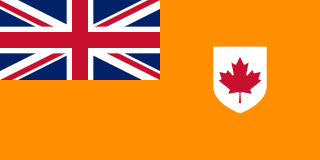
The World Federation of Trade Unions (WFTU) is an international federation of trade unions established in 1945. Founded in the immediate aftermath of World War Two, the organization built on the pre-war legacy of the International Federation of Trade Unions as a single structure for trade unions world-wide, following the World Trade Union Conference in London, United Kingdom.

Canada East was the northeastern portion of the Province of Canada. Lord Durham's Report investigating the causes of the Upper and Lower Canada Rebellions recommended merging those two colonies. The new colony, known as the Province of Canada, was created by the Act of Union 1840 passed by the Parliament of the United Kingdom, having effect in 1841. For administrative purposes, the new Province was subdivided into Canada West and Canada East. The former name of "Lower Canada" came back into official use in 1849, and as of Canadian Confederation of 1867 it formed the newly created province of Quebec.
In British politics, an affiliated trade union is one that is linked to the Labour Party. The party was created by the trade unions and socialist societies in 1900 as the Labour Representation Committee and the unions have retained close institutional links with it.

The Communist Party of Canada is a federal political party in Canada. Founded in 1921 under conditions of illegality, it is the second oldest active political party in Canada, after the Liberal Party of Canada. Although it does not currently have any parliamentary representation, the party's candidates have previously been elected to the House of Commons, the Ontario legislature, the Manitoba legislature, and various municipal governments across the country.

Alberta Social Credit was a provincial political party in Alberta, Canada, that was founded on social credit monetary policy put forward by Clifford Hugh Douglas and on conservative Christian social values. The Canadian social credit movement was largely an out-growth of Alberta Social Credit. The Social Credit Party of Canada was strongest in Alberta, before developing a base in Quebec when Réal Caouette agreed to merge his Ralliement créditiste movement into the federal party. The British Columbia Social Credit Party formed the government for many years in neighbouring British Columbia, although this was effectively a coalition of centre-right forces in the province that had no interest in social credit monetary policies.

George Anthony "Boomer" Walkem was a British Columbian politician and jurist.

The Bow River is a river in Alberta, Canada. It begins within the Canadian Rocky Mountains and winds through the Alberta foothills onto the prairies, where it meets the Oldman River, the two then forming the South Saskatchewan River. These waters ultimately flow through the Nelson River into Hudson Bay. The Bow River runs through the city of Calgary, taking in the Elbow River at the historic site of Fort Calgary near downtown. The Bow River pathway, developed along the river's banks, is considered a part of Calgary's self-image.

The International Union of Operating Engineers (IUOE) is a trade union within the United States-based AFL–CIO representing primarily construction workers who work as heavy equipment operators, mechanics, surveyors, and stationary engineers who maintain heating and other systems in buildings and industrial complexes, in the United States and Canada.

The Christian Labour Association of Canada (CLAC) is a labour union that represents companies in the construction, healthcare, and food industries. It was established in 1952 to represent workers on the basis of "Christian social principles". The union claims that its approach to labour relations develops workers' sense of responsibility, participation, stewardship, and dignity. It opposes what it calls the undemocratic, adversarial, and monopolistic practices of the labour movement. It has been characterized by other Canadian trade unions for being a "company union" for its support of employer friendly legislation.
A company or "yellow" union is a worker organization which is dominated or unduly influenced by an employer and is therefore not an independent trade union. Company unions are contrary to international labour law. They were outlawed in the United States by the 1935 National Labor Relations Act §8(a)(2), due to their use as agents for interference with independent unions. However, company unions persist in many countries.

The Grand Orange Lodge of British America, more commonly known as the Grand Orange Lodge of Canada or simply Orange Order in Canada, is the Canadian branch of the Orange Order, a Protestant fraternal organization that began in County Armagh in Ireland in 1795. It has played a large part in the history of Canada, with many prominent members including four prime ministers, among them Sir John A. Macdonald and John Diefenbaker.

The North Saskatchewan River is a glacier-fed river that flows from the Canadian Rockies continental divide east to central Saskatchewan, where it joins with the South Saskatchewan River to make up the Saskatchewan River. Its water flows eventually into the Hudson Bay.
Frederick Gordon Bradley was a Canadian and Dominion of Newfoundland politician.
The organizations listed below constitute the Canadian Labour Congress, the national federation of trade unions:

The Confederation of Canadian Unions is a national trade union centre, a central labour body of independent unions in Canada.

The Confederation of Shipbuilding and Engineering Unions (CSEU), often known as the Confed is a trade union confederation in the United Kingdom.

The Irish Congress of Trade Unions, formed in 1959 by the merger of the Irish Trades Union Congress and the Congress of Irish Unions, is a national trade union centre, the umbrella organisation to which trade unions in both the Republic of Ireland and Northern Ireland affiliate.

The Building and Construction Trades Department, commonly known as North America's Building Trades Unions (NABTU), is a trade department of the American Federation of Labor and Congress of Industrial Organizations (AFL–CIO) with 14 affiliated labor unions in the building trades. It was originally founded by the American Federation of Labor in 1907.













